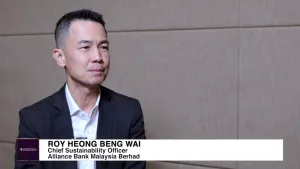
Is 2023 the year Southeast Asia’s financial services become future-ready?
Southeast Asia’s financial services institutions (FSIs) are bracing themselves for another year of volatile geopolitical and economic conditions, with record-high inflation and rising interest rates. But those willing to push the digital envelope will find new pockets of growth to help them remain resilient and become future-ready. For this to happen, FSIs need their executives to embrace a digital-era transformative mindset – one that builds skills, flexibility and agility, preparing their organizations to pivot at any moment.

When it comes to digital transformation, the sector is at an inflection point, with embedded finance leading the charge. FSIs that significantly invested in digital capabilities during the COVID-19 pandemic already have more agility to adapt to the trends now reshaping the sector. Those that took a more cautious approach are now focusing sharply on gaining the technology, data and analytics capabilities that will be critical future enablers to modernize and push their businesses forward.
The big driver is the need to meet customers’ expectations, which are changing faster than FSIs can track them. This was borne out in the 2022 EY Tech Horizon survey, where incumbent FSIs cited “meeting customer needs” as their number one digital transformation objective. More than half of the participants also named their “difficulty in tracking customer needs” as the primary barrier to improving the customer experience.
The survey also found that data and analytics is the second-highest area of technology investment within the Asia-Pacific financial services sector (behind blockchain) – with investment growing since 2020. This shift to data-centricity is aimed at addressing data gaps, which respondents say are the number one challenge to meeting financial sector customer needs.
In insurance, the shift to big data has opened the door for new sources of information that can be used to influence underwriting, rating and pricing – and support personalization. The region’s insurers know that the advanced analytics will play an important role in their future growth, but talent gaps, data availability and integration challenges are holding them back.
“Insurers need additional focus on ensuring more seamless services by enabling technology across the delivery chain and enriching product offerings to the direct customer and via digital sales portals.” Brandon Bruce, EY Asean Insurance Leader.
Wealth and asset managers are equally challenged by big data, with more harnessing technology to generate advice. Today, financial advisors spend a vast majority of time entering data into systems, and most of the time it is the same data being added into multiple systems. Digitization will change this equation, giving advisors more time to spend with their customers and grow their business.
Where are the areas of opportunity for future-ready financial services institutions?
FSIs can find long-term value by tapping into the substantial growth headroom in:
- Product innovation, especially to align with consumers’ ESG agenda
FSIs have important opportunities to use data to empower customers to act in line with their goals and values. As sectors converge, and banking becomes “invisible”, data, combined with behavioral economics and affective computing will be instrumental in helping people better manage their finances.
We’re already seeing apps to help customers reach their savings goals. In 2023, we expect to see FSIs making people aware of the carbon footprint caused by their spending patterns and suggesting an alternative, lower-carbon options – and the parallel growth of green insurance options.
" While banks have already focused on improving the customer interface, they still need to modernize their core systems. This is vital to enabling personalization and developing new products.” Seah Li Yun, EY Asean Banking and Capital Markets Leader.
However, as FSIs pursue these strategies, investments in data must be future-proofed. A recent EY Tapestry network report highlighted that 70% of data investments over the past decade are not reusable and do not address broader transformational capabilities.
To solve this problem, EY Nexus, a flexible, cloud-native acceleration platform, is designed to enable end-to-end experiences through which FSIs can design, build, launch and enhance propositions, dynamically pivoting to customers’ ever-shifting expectations. EY Nexus can tuck into every corner of the industry, with the ability to build a new bank or insurance company outside of an organization’s legacy systems at incredible speed. What’s more, this can be achieved with existing systems, providing frictionless integration without disrupting the operating model.
- Blockchain
While the evolution of blockchain in the sector began with building the blockchains, protocols, privacy technology and scaling solutions needed for growth, more recently it has extended to decentralized use cases in the region’s capital markets. For example, traditional FSIs are now offering hedge funds and deposit accounts on blockchain with no intermediaries.
In 2023, we also expect institutions to use blockchain to capture, consolidate and process data relating to the carbon emissions of asset portfolios. Blockchain is particularly well-suited to this because it ensures high levels of data trust and integrity.
- Ecosystem models
Embedded finance has become part of the fabric of everyday life and one of the region’s key drivers in creating accessible digital ecosystems. Populations in Southeast Asia are gaining access to a growing range of virtual financial services, and at a faster rate than in most of the world’s other markets.
The focus is shifting to using ecosystem models to own the full aspects of a customer relationship. In 2023, FSIs will rapidly monetize their customer base with additional revenue streams and vertically scaled products that increase customer lifetime value. Equally, in the region’s massive SME market, we will see small merchants increasingly adopting digital financial ecosystem solutions that allow them to access financial services, like credit or commercial insurance.
An FSI’s digital transformation efforts depend on hiring and retaining skilled talent in a competitive landscape. The growing need to upskill and reskill existing employees to address the skills gap, coupled with employees’ interest in advancing their own knowledge, highlights the importance of continuous learning across the organization.
When it comes to attraction and retention, EY Asia-Pacific Belonging Barometer 2022 found that employees who feel like they strongly belong are three times as likely to stay with their current employer. Trust, respect and a connection to others through similar or shared interests, skills and challenges define the feeling of belonging. The Belonging Barometer highlights that workplace diversity and the opportunity for hybrid working both increase employee retention.
2023 will be a year of innovation
Our region is already home to some of the world’s most advanced FinTech markets. As we look towards 2023, we can expect the financial services sector to continue to benefit from a powerful FinTech feedback loop, with increased adoption driving increased innovation – and vice versa especially as the region continues to attract investment.
“The inflow of capital into Southeast Asia continues to grow steadily. In particular, Indonesia, Vietnam, the Philippines and Thailand are attracting investments across asset classes – and Singapore is well-positioned to be the gateway into the region.” Mriganko Mukherjee, EY Asean Wealth and Asset Management Leader and EY Asia-Pacific Wealth & Asset Management Tax Leader.
For existing larger financial services institutions, responding to the customers’ immediate needs is not enough. Leaders and organizations must be prepared to iterate and experiment, to get under the skin of their customers and have a firm grasp of what is disrupting their industry. This is the digital-era transformation mindset that results in long-term value.
With legacy technology slowing down product development and innovation, rapid digital transformation will be the decisive strategy to be future-ready in the years to come. In this age of immediacy and instant gratification, customers expect an exceptional experience and seamless end-to-end services. If an institution cannot provide this in 2023, they can be sure that a more future-ready organization will.
If you would like a conversation on how EY teams can help you stay focused on the future of financial services in Southeast Asia – one that is stronger, fairer, and more sustainable, please connect with me over LinkedIn. You can also access our latest thinking and learn about our capabilities or subscribe to Ignite, the EY Asean Financial Services newsletter to stay updated.
The views reflected in this article are the views of the author and do not necessarily reflect the views of the global EY organization or its member firms.



















 Advertise
Advertise







